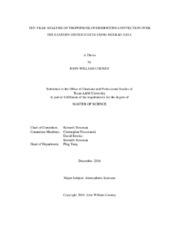| dc.description.abstract | Mass-exchange across the tropopause can have a substantial impact on the composition, radiation, and chemistry of the Upper Troposphere and Lower Stratosphere (UTLS). Convection that penetrates the tropopause (overshooting convection) can rapidly transport air from the lower troposphere to the lower stratosphere and can potentially mix stratospheric air into the upper troposphere. To improve our understanding of overshooting convection, this study conducts a 10-year statistical analysis of overshooting convection for the May-August period of 2004 to 2013 over the continental United States, east of the Rocky Mountains. Using 104 radars from the National Oceanic and Atmospheric Administration Next Generation Weather Radar (NEXRAD) network, echo-top altitudes are derived from radar reflectivities that are merged into hourly, high-resolution, three-dimensional, gridded synoptic analyses. Echo-top altitudes are then compared to lapse-rate tropopause heights calculated from the European Center for Medium-Range Weather Forecasting ERA-Interim reanalysis to determine the frequency, timing, magnitude, location, and interannual variability of overshooting convection. The results of this study are obtained from analyzing only the ‘storms’ identified to protrude at least 2 km into the lower stratosphere.
Overshooting convection is most common in the high plains of the United States, with a weak secondary maximum observed along the east coast. There is a strong diurnal cycle with maximum overshooting occurring consistently between 2200 and 0200 UTC (late afternoon to early evening local time). The number of events per year varies by about a factor of two with 2011 having the most and 2005, the least. The total overshooting volume for each year follows a similar pattern as the occurrences. The tropopause height is found to play an important role in controlling overshooting. There are more overshooting events observed in May and June when the tropopause height is low than in July and August. The highest number of overshooting storms have echo-top heights ranging from 15 km in May to 18 km in August. The number of storm occurrences also decreases exponentially with height above the tropopause and none are observed to extend over 8 km into the stratosphere. In this study, over 70% of individual overshooting storms have echo-tops with potential temperature values at or above 380 K, suggesting that the impact of overshooting over the United States could extend beyond the mid-latitudes and potentially into the tropical lower stratosphere. | en |


